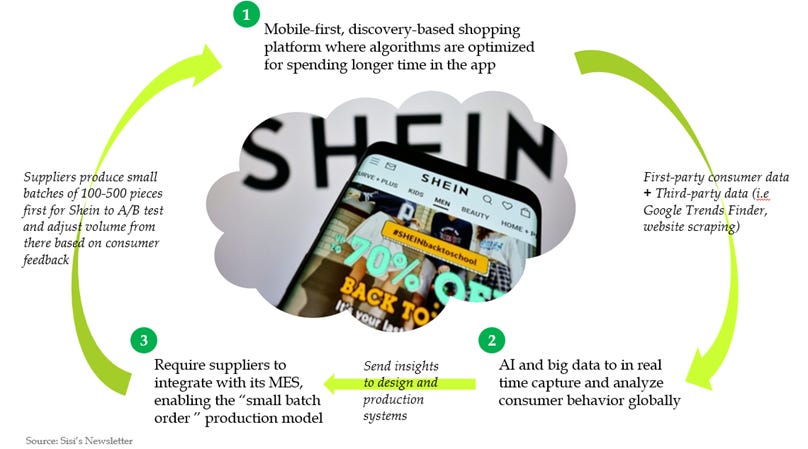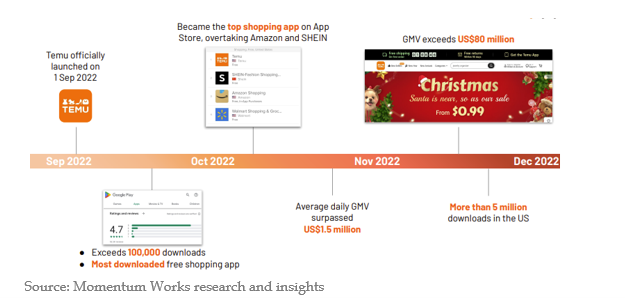Reports say that Chinese online fashion retailer Shein, which sells ultra fast-fashion clothing at discount prices to mostly Gen Z consumers outside of China, is planning an IPO this year. Though macro headwinds have investors questioning whether Shein can maintain its high level of growth — it has grown on average more than 100% a year since its founding in 2008 — I think the bigger implication of Shein’s success is that it marks the beginning of what I’d call “China Cross-border Commerce 3.0,” which I define as the rise of cross-border B2C platforms with Chinese characteristics. And with that, a host of exciting opportunities for global startups to follow in its footsteps. I'm going to address both of those topics in this piece.
Shein and its three pillars of commerce
Where China Cross-border Commerce 1.0 comprised bulk business-to-business (B2B) transactions between Chinese manufacturers and corporate customers overseas, and 2.0 was the era of business-to-consumer (B2C) transactions through platforms such as AliExpress, eBay, Amazon, Wish, and Shopee, 3.0 will be the proliferation of innovations in commerce that first appeared in China — livestreaming and social commerce, mobile-first shopping, a discovery-based buyer’s journey — in markets overseas. Shein has been at the forefront of many of these innovations, and more, and I’d like to highlight three pillars that I believe have been most important for the company.
Discovery-based algorithms
One key difference I observe in Western commerce vs. Chinese commerce is that, in the West, commerce websites are predominantly search-based and compete with each other on matching accuracy. The more accurate the platform, the idea goes, the less time that users need to find what they want.
However, commerce platforms originating in China, including Shein, Taobao, and Pinduoduo, took a different approach. They are discovery-based, and their algorithms are partly optimized for customers to spend more time in their apps. They present products to users the way TikTok shows users endless video recommendations. And those recommendations are updated in real time based on users’ latest browsing history to drive conversion. Shein also built gamified features to reward users for frequent logins, longer video/photo reviews, and so on.
I’m excited about the potential for discovery-based e-commerce platforms. I open Shein’s app when I’m bored to browse and fill my shopping cart, but I don’t do that on Amazon. As Connie Chan said, “Discovery-based shopping better mimics the in-store shopping experience. Think of it as the digital equivalent of walking into a Target with the aim of buying one item and walking out with a dozen.” Given the contradictory goals of search-based paths vs. discovery-based paths, it will take existing search-based platforms a while to convert into discovery-based platforms in order to compete.
AI for local understanding
Lack of local knowledge prohibited Chinese merchants from capturing consumer behavior in the past, and only those at scale were able to afford to hire designers and localization teams. Shein overcame this problem by building AI and big-data analytics to capture consumer behavior in real time. Being mobile-first also helped the company collect more detailed behavioral data given the amount of time that consumers spend on their phones. First-party data combined with macro data from tools such as Google Trend Finder allow Shein to collect data in real time to update its production levels and to be more accurate with pattern matching between consumer behavior and purchase decisions. The more purchasing data that Shein accumulates, the more accurately its AI identifies patterns vs. noise.
The 'small batch order’ production model
Coordination with suppliers and manufacturers was mostly done offline and manually in the past. That may work when a company partners with only a dozen suppliers, but Shein has over 3,000. To solve this problem, Shein concentrated its supply chain mainly in Guangzhou, the fashion manufacturing capital of China. Guangzhou has the most comprehensive manufacturing chain covering materials from yarn and textile to embroidery. Additionally, since 2015, Shein has invested heavily in its in-house manufacturing execution system (MES) and now requires all of its suppliers and manufacturers to integrate with its MES so that they can take order requests in real time. Such agility has made the “small batch order” production model possible. Suppliers produce small orders of about 100–500 pieces for Shein to A/B test and adjusts volume from there based on consumers’ real-time feedback. As a result, Shein shortens its lead time to as little as one week and adds on average about 6,000 new items every day.
China Cross-border Commerce 3.0
The success of Shein, combined with accelerated e-commerce penetration overseas during COVID-19, has led to a short spike of cross-border direct-to-consumer (DTC) fundraising in China. In 2021 alone, 100+ venture rounds were raised by startups building cross-border DTC brands and enablement tools. At the same time, China e-commerce conglomerates, suffering from a domestic economic slowdown and regulatory overhang, all eyed overseas markets as the next driver of growth. They noticed that while Chinese e-commerce had gone through many innovations — becoming mobile-first, the rise of social and livestreaming commerce, discovery-based commerce to community group buying, and so on — e-commerce in many other regions were more like China seven years ago, when it was predominantly PC and search-based. Now, China e-commerce conglomerates are ambitious to not only export China’s supply-chain advantages but also to shape how overseas consumers shop online with their homegrown models. Two examples are:
Temu
A formidable challenger to Alibaba in China, Pinduoduo launched Temu in the U.S. in September 2022 and has grown aggressively since then. It reached an average daily GMV of $1.5 million in just two months and was downloaded more than 5 million times by last December. Temu’s front-end is a discovery-based platform that determines what to present to consumers in real time. In the backend, Pinduoduo expanded existing manufacturer relationships and optimized its cost structure from its domestic business and scaled it to overseas markets. This allowed Temu to reduce intermediary costs to offer “lower than Shein” prices for buyers. To show its ambitions overseas, Pinduoduo has already thrown hundreds of millions of dollars toward paid ads, influencer marketing, and promotions, even a Super Bowl ad (Shop like a Billionaire).
TikTok Shop
TikTok’s sister app, Douyin, pioneered livestreaming commerce in China and grew its GMV to $208 billion in four years by 2022. In 2021, TikTok launched its livestreaming shopping feature Tiktok Shop in Southeast Asia and the U.K, and it is now beta-testing it in the U.S. On top of its unique know-how from China, TikTok takes a hands-on approach to educating overseas markets on how to do livestreaming commerce, including training influencers in-house and developing logistics infrastructure to guarantee a positive buyer experience.
I will revisit these platforms in detail in a future post (subscribe here), it will suffice for now to note their Chinese characteristics: 1) applying online shopping models proven in China to shape consumer purchasing behavior overseas; 2) further optimizing supply chain cost structures by leveraging the scale of economies from their domestic business and China’s super manufacturing power.
Though overseas expansion comes with its own set of challenges for Chinese e-commerce conglomerates — namely geopolitical tensions, different consumer behavior, etc. — I would imagine that cross-border B2C platforms with Chinese characteristics will contribute meaningfully to the global e-commerce market in the coming years.
Opportunities for startups
The rise of new platforms in Commerce 3.0 will undoubtedly unleash many exciting opportunities for startups. Here are some for entrepreneurs that I’m excited about:
• New categories of merchants to serve: Social commerce and livestreaming commerce enabled by Commerce 3.0 will give rise to new categories of merchants. Many of them are creators and influencers who own organic traffic and know how to sell. Still, there is opportunity for smart founders who can help these merchants produce, source, and customize products more easily. Think product design, inventory management, and contract negotiation, etc.
• AI to replace managed services: There are many low margin and labor-intensive managed services in cross-border transactions, such as product listing, marketing, content generation, and customer support. I am particularly interested in enablement tools that automate them. Also, as large AI models mature, I expect AI to do more of the managed-services work, if not all of it. For example, I have already seen cross-border businesses use GPT-3 to improve their engagement with overseas consumers and overcome language barriers.
• Help cross-border businesses localize: As more cross-border commerce platforms arrive in overseas markets, foreign sellers will have a greater opportunity to reach consumers there. But that will require more and more sophisticated localization services to help them succeed there. Examples of these services include UI/UX and brand operations targeting consumers in destination markets, software keeping sellers up to date on local compliance requirements. I believe many cross-border businesses are eager to pay for tools that can help them overcome localization challenges so that they can focus on products and customers.
If you are building businesses enabling cross-border commerce or just to want to chat about the space, please get in touch. As I said, this is only the beginning and I’d love to hear from you!






This is such a great piece! I love seeing a former student emerge as a thought leader. Sisi, I'm writing a Shein / Temu chapter in the next version of my IS Textbook and I'll certainly cite and reference your work. Thanks for sharing your knowledge. Soar! 🦅
Do you see an opportunity for these sellers who participate in MES to become DTC and directly sell on FB and Google? Why or Why not?